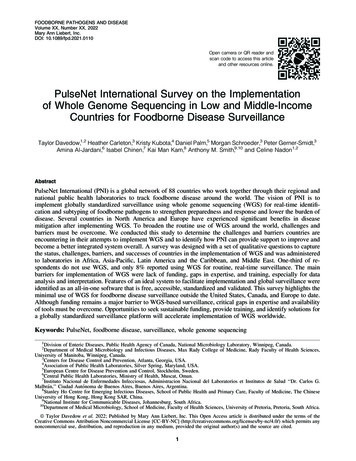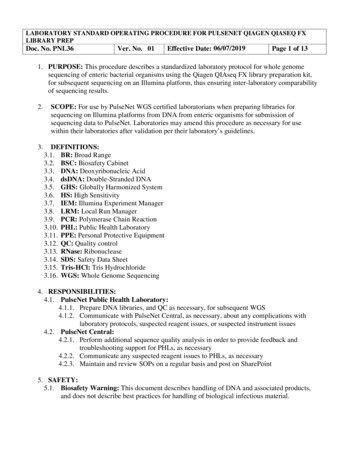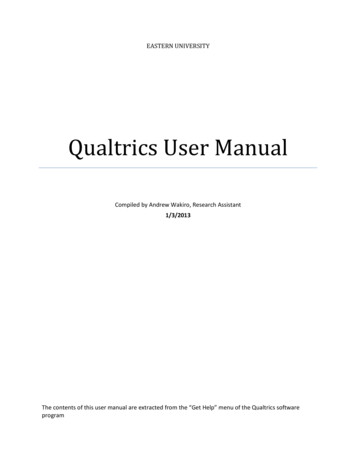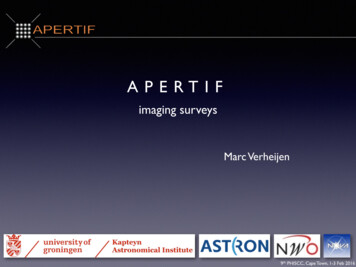
Transcription
FOODBORNE PATHOGENS AND DISEASEVolume XX, Number XX, 2022Mary Ann Liebert, Inc.DOI: 10.1089/fpd.2021.0110Open camera or QR reader andscan code to access this articleand other resources online.PulseNet International Survey on the Implementationof Whole Genome Sequencing in Low and Middle-IncomeCountries for Foodborne Disease SurveillanceTaylor Davedow,1,2 Heather Carleton,3 Kristy Kubota,4 Daniel Palm,5 Morgan Schroeder,3 Peter Gerner-Smidt,3Amina Al-Jardani,6 Isabel Chinen,7 Kai Man Kam,8 Anthony M. Smith,9,10 and Celine Nadon1,2AbstractPulseNet International (PNI) is a global network of 88 countries who work together through their regional andnational public health laboratories to track foodborne disease around the world. The vision of PNI is toimplement globally standardized surveillance using whole genome sequencing (WGS) for real-time identification and subtyping of foodborne pathogens to strengthen preparedness and response and lower the burden ofdisease. Several countries in North America and Europe have experienced significant benefits in diseasemitigation after implementing WGS. To broaden the routine use of WGS around the world, challenges andbarriers must be overcome. We conducted this study to determine the challenges and barriers countries areencountering in their attempts to implement WGS and to identify how PNI can provide support to improve andbecome a better integrated system overall. A survey was designed with a set of qualitative questions to capturethe status, challenges, barriers, and successes of countries in the implementation of WGS and was administeredto laboratories in Africa, Asia-Pacific, Latin America and the Caribbean, and Middle East. One-third of respondents do not use WGS, and only 8% reported using WGS for routine, real-time surveillance. The mainbarriers for implementation of WGS were lack of funding, gaps in expertise, and training, especially for dataanalysis and interpretation. Features of an ideal system to facilitate implementation and global surveillance wereidentified as an all-in-one software that is free, accessible, standardized and validated. This survey highlights theminimal use of WGS for foodborne disease surveillance outside the United States, Canada, and Europe to date.Although funding remains a major barrier to WGS-based surveillance, critical gaps in expertise and availabilityof tools must be overcome. Opportunities to seek sustainable funding, provide training, and identify solutions fora globally standardized surveillance platform will accelerate implementation of WGS worldwide.Keywords: PulseNet, foodborne disease, surveillance, whole genome sequencing1Division of Enteric Diseases, Public Health Agency of Canada, National Microbiology Laboratory, Winnipeg, Canada.Department of Medical Microbiology and Infectious Diseases, Max Rady College of Medicine, Rady Faculty of Health Sciences,University of Manitoba, Winnipeg, Canada.3Centers for Disease Control and Prevention, Atlanta, Georgia, USA.4Association of Public Health Laboratories, Silver Spring, Maryland, USA.5European Centre for Disease Prevention and Control, Stockholm, Sweden.6Central Public Health Laboratories, Ministry of Health, Muscat, Oman.7Instituto Nacional de Enfermedades Infecciosas, Administracion Nacional del Laboratorios et Institutos de Salud ‘‘Dr. Carlos G.Malbrán,’’ Ciudad Autónoma de Buenos Aires, Buenos Aires, Argentina.8Stanley Ho Centre for Emerging Infectious Diseases, School of Public Health and Primary Care, Faculty of Medicine, The ChineseUniversity of Hong Kong, Hong Kong SAR, China.9National Institute for Communicable Diseases, Johannesburg, South Africa.10Department of Medical Microbiology, School of Medicine, Faculty of Health Sciences, University of Pretoria, Pretoria, South Africa.2ª Taylor Davedow et al. 2022; Published by Mary Ann Liebert, Inc. This Open Access article is distributed under the terms of theCreative Commons Attribution Noncommercial License [CC-BY-NC] (http://creativecommons.org/licenses/by-nc/4.0/) which permits anynoncommercial use, distribution, and reproduction in any medium, provided the original author(s) and the source are cited.1
2IntroductionBackgroundPulseNet International (PNI) is a global network ofnational, regional, and subregional laboratories andlaboratory networks of 88 countries that span Africa, AsiaPacific, Canada, Europe, Latin America and the Caribbean,Middle East, and the United States. PNI has implementedstandardized genotyping methods around the world, pioneered sharing of subtyping data for surveillance and outbreak response, and enabled global data sharing throughcapacity building and training activities (Swaminathan et al.,2006; Nadon et al., 2013).Standardized subtyping methods pulsed-field gel electrophoresis and multilocus variable-number tandem-repeat analysis, in use for many years, were ultimately replaced beginningin the mid-2010s when evidence emerged that whole genomesequencing (WGS) was far superior in performance (e.g.,sensitivity, specificity, and the ability to resolve clusters).The benefits of WGS were estimated to be significant enough to warrant the substantial upheaval that its implementation would cause. The high resolution and epidemiologicalconcordance of WGS, plus the potential for unambiguousnomenclature amenable to global surveillance compelled anew vision for PNI: to implement WGS for foodborne diseasesurveillance worldwide (Nadon et al., 2017).Benefits of WGS for foodborne disease surveillanceand outbreak responseSeveral countries in North America, Europe, and elsewherehave already experienced significant benefits in outbreak detection, response, and disease mitigation after implementingWGS. In the United States, WGS for foodborne disease surveillance is viewed as paradigm shifting ‘‘precision publichealth’’; the beginning of a new era where pathogen genomicsis anticipated to provide improvements for all areas of infectious diseases (Armstrong et al., 2019; Kubota et al., 2019).Implementation of WGS has led to numerous benefitscompared with molecular subtyping. For example, WGS(combined with epidemiological and food safety tracebackdata) led to an increase in the proportion of listeriosis outbreaks that could be solved ( Jackson et al., 2016). In Europe,WGS is a key part of the European Centre for Disease Prevention and Control Public Health Microbiology Strategy for2018–22, and by 2017 had been implemented in 18 countriesof the European Union/European Economic Area (ECDC,2018, 2019).In Europe, WGS has enabled linking of sporadic caseswith food products, improved outbreak investigations andsource attribution and identified transmission pathways andantimicrobial resistance (ECDC, 2019). In Canada, usingWGS for routine surveillance led to increases in outbreakresolution, epidemiological concordance, and led to the detection and linkage of multiple Salmonella Enteritidis outbreaks to food products that rapidly led to changes tonational food safety policy and a subsequent decrease indisease incidence (Rumore et al., 2018; Morton et al., 2019).Laboratories in Australia, New Zealand, China, and LatinAmerica and the Caribbean have described similar benefits(Kwong et al., 2016; Baker et al., 2017; Ford et al., 2018;Zhang et al., 2020).DAVEDOW ET AL.The benefits of WGS have also been realized in smallercountries, where the improved performance plus the all-inone workflow and reduction in labor-intensive steps of WGSare appealing to small countries (Nouws et al., 2020). In SouthAfrica, the Centre for Enteric Diseases was in the early stagesof WGS implementation when the technology was thrust intoprominence and lauded for its critical role in resolving theworld’s largest listeriosis outbreak in 2017 (Smith et al.,2019). A national surveillance system using WGS was thenimplemented in South Africa, demonstrating the feasibility ofWGS use in a middle-income country (Thomas et al., 2020).Challenges with implementationThe four main areas of challenges for WGS implementation, as experienced by early adopters, include organizational(i.e., legislative/regulatory barriers, economic drivers, andfunding), cultural (cross-sector collaboration, language barriers, and resistance to change), technical (data storage andcomputing power), and scientific (sequence generation andbioinformatics) (WHO, 2018).An economic analysis of WGS implementation for Salmonella found that WGS costs 1.2–4.3 times more than traditionalmolecular methods, but that the resulting benefits would offsetthis difference even if WGS leads to only a relatively smallnumber of cases prevented (Alleweldt et al., 2021). Indeed, theAfrica Centres for Disease Control and Prevention recentlylaunched a US 100-million Pathogen Genomics Initiative tointegrate pathogen genomics and bioinformatics for improveddisease control and prevention in Africa (Makoni, 2020).Despite these examples of economic benefits and advantages, many countries still struggle. Although sustainablefunding may be considered a universal root cause of slowimplementation, the paradigm shift that WGS represents maypresent a more nuanced set of challenges to be overcome.Although WGS is also being planned for implementation indisease surveillance in many countries for many pathogens, theglobal COVID-19 pandemic has vastly and rapidly expandedthe critical importance of genomics to the prevention andcontrol of infectious diseases (Cardona-Ospina et al., 2021).These advances owing to COVID-19 may provide an opportunity for other infectious disease areas to leverage the progressfor targeting genomics-based modernizations across the board.PurposeTo broaden the routine use of WGS for foodborne diseasesurveillance and response worldwide, challenges and barriersmust be identified. As a network, PNI is positioned to provideguidance and advocacy for capacity building and international surveillance; however, additional intelligence onwhere to best focus activities is needed. The purpose of thisstudy was to ascertain the status of WGS implementation forfoodborne disease surveillance and outbreak response bylaboratories in low and middle-income countries (LMICs)participating in PNI regional networks, and to identify thespecific challenges and barriers to implementing WGS.MethodsSurvey designA qualitative survey, comprising multiple choice andopen-ended questions, was designed to capture status,
PULSENET INTERNATIONAL SEQUENCING ACTIVITIES3challenges, barriers, and plans of laboratories in WGS implementation during the 2019 calendar year (SupplementaryTable S3).RStudio Team, 2020). Questions with no responses werecoded as missing values and were excluded from the analysisfor that question; thus, response rates were tabulated for eachquestion individually.Sampling plan and data collectionA total of 54 PNI-participating countries with laboratoriesin Africa, Asia-Pacific, Latin America and the Caribbean,and Middle East were invited to complete the survey. Thesurvey was administered online via Google Forms (Alphabet, Inc., USA) by invitation only. There were no exclusioncriteria. Institutional Review was not required for thistechnical survey with no human data.Quantitative and qualitative analysisSurvey respondents were deidentified (names and institutes anonymized). Answers were converted into key messages and stratified by country and region in Excel(Microsoft, USA) following general grounded theory methodology (Corbin and Strauss, 2008). Initially, responses werecoded to categories, then re-examined to identify concepts,and then assessed for trends, themes, and deviations. Multiplechoice questions and coded qualitative responses were analyzed and visualized using the ggmap and ggplot2 packagein RStudio (Kahle and Wickham, 2013; Wickham, 2016;Results and DiscussionThe survey represents a cross-section of laboratories inLMICs. Forty-one institutions from 33 of the 54 countriescompleted the survey: a response rate of 61% (country level).The survey was administered in early 2020, that is, at thebeginning of the global COVID-19 pandemic. Many, if notall, the targeted laboratories were involved to various degreesin the initial pandemic response, and this could have impacted the response rate. The responding laboratories spanned all regions of PNI: Africa (42%), Asia-Pacific (15%),Latin America and the Caribbean (20%), and Middle East(25%) (Fig. 1). The majority of laboratories (66%) werenational reference laboratories, including those from nationalpublic health, agriculture, and food safety authorities. Theremaining laboratories were from the academic and researchsector (24%) or could not be categorized (10%).WGS implementation is underway, but use in surveillanceis highly limited. Only 8% of the laboratories use WGS forroutine foodborne disease surveillance (Fig. 2A). A largerFIG. 1. Map of PNI participating countries that responded to the survey (n 41). Colors represent the PNI regions and thedarkening of shades indicates countries with ‡2 survey responses. The country breakdown of responses is given below themap. *Countries are identified as belonging to regions as per the PNI networks, found at pulsenetinternational.org. PNI,PulseNet International.
4DAVEDOW ET AL.FIG. 2. Characterization of WGS use for foodborne disease surveillance based on PNI region (A; n 37). The WGSimplementation plans (B; top) and current location of sequencing (B; bottom) is faceted by current sequencing activities(n 34). Other responses were described as using WGS for genetics, virology, surveillance of antimicrobial resistance, andacademia. Institutions that provided a response to their current sequencing activities (A), but did not provide a response in(B) were coded as ‘‘No response.’’ PNI, PulseNet International; RT, real-time; WGS, whole genome sequencing.proportion (20%) use WGS for outbreak investigations afterthey are identified by other means (e.g., molecular subtyping), and 28% use WGS for research and pilot studies only.Of the laboratories that currently do not have WGS implemented, 40% reported that they outsource sequencing toanother institution (e.g., commercial partner, academic institution, or government laboratory), but have plans to implementWGS in-house around or after 2022 (47% and 27%, respectively) (Fig. 2B). Twenty percent of laboratories do not currently use WGS for foodborne disease surveillance, althoughsequencing is performed on-site for other purposes. The majority of laboratories that use WGS for investigations after anoutbreak (63%) or for pilot studies (55%) perform sequencing attheir own institution. Of these, 13% and 27%, respectively, planto implement WGS at their own institution by 2022. All thelaboratories that use WGS for routine, real-time surveillanceperform these sequencing activities at their own institution.In 2019 only 5% of laboratories sequenced over 1000isolates (data not shown). Although 66% of laboratories sequenced 0–100 isolates that year, the remaining laboratoriessequenced between 100 and 1000 isolates. The majority ofsequencing was performed on priority foodborne pathogens:Salmonella (75%), Escherichia coli/Shigella (45%), Vibrio(20%), Campylobacter (15%), and Listeria (10%).The capacity for generating sequences is generally higherthan the capacity for analyzing or interpreting the data. Sixtyone percent of respondents indicated their capacities forutilizing, optimizing, and troubleshooting wet lab protocolsfor WGS were good to excellent (Fig. 3A). Approximately70% of laboratories reported using Illumina instrumentation,with MiSeq being the most common model used (data notshown). Other platforms reported included Oxford Nanopore,Ion Torrent, and Pacific Biosciences. Capacity for computation and bioinformatics was found to be generally low.Local high-performance computing is available in 28% oflaboratories, the remaining laboratories rely on laptop computers (28%), external hard drives (14%), cloud-based resources (11%), onsite servers (11%), or a combination of theabove (6%) for computing and storage (Fig. 3C).Forty-four percent of responses characterized their laboratories’ capacity and expertise to utilize, develop, optimize,and troubleshoot bioinformatics analysis protocols for WGSdata as little or none (Fig. 3B). Core- or whole-genome MLSTwas identified as the in silico subtyping method used for determining allelic differences in 50% of laboratories, followedby single nucleotide polymorphism/single nucleotide variant(SNP/SNV)-based approaches (25%; data not shown). Atleast 75% of the laboratories that use WGS also use in silicophenotype prediction tools for antimicrobial resistance, virulence factors, and serotype.The majority of laboratories (61%) do not have establishedguidelines for interpreting WGS data (e.g., number of alleleor SNV/SNP differences for outbreak detection), whereas21% rely on interpretation criteria developed by others orfound in the literature (consulting with bioinformaticians,epidemiologists, and external partners as needed). Only 9%of laboratories have established guidelines, and another 9%interpret results on a case-by-case basis.
PULSENET INTERNATIONAL SEQUENCING ACTIVITIES5FIG. 3. Characterization of responding laboratories capacity to optimize and troubleshoot whole genome sequencing wetlab protocols (A; n 38), and bioinformatics analysis (B; n 36). Part (C) summarizes the available computing and storagecapacity (n 36). ‘‘Other’’ included: using a combination of resources or capacity is limited.End-user knowledge for effective use of WGS data is low.The primary users of WGS data for outbreak detection andsurveillance are epidemiologists (60%), ministry of health orequivalent authorities (40%), researchers/academicians (29%),and biologists (i.e., microbiologists, bacteriologists, and geneticists; 23%; Fig. 4A). Only 33% of laboratories characterized the level of knowledge and ability to utilize WGS data forpublic health decision-making as good to excellent (Fig. 4B).The remaining laboratories indicated their capacity to do sowas moderate (19%) or minimal/nonexistent (48%).The dissemination of WGS results is largely achievedthrough traditional mechanisms, and data sharing is highlylimited. For cluster and outbreak detection, subtyping resultsare communicated to stakeholders through a variety of ways.Traditional methods, including excel spreadsheets (32%),hard copies (including fax; 24%), and in-person or telephonecommunication (18%), dominated over modern communication methods such as laboratory information managementsystems and internal bespoke websites (18%). A few laboratories disseminate WGS findings through formal writtenreports and manuscripts as their primary method of communication (9%; Fig. 5B).Although 68% of laboratories produce and share phylogenetic trees, the majority (56%) of laboratories do not
6DAVEDOW ET AL.FIG. 4. The end users of WGS data (A; n 35) and characterization of the laboratories capacity to utilize data fordecision-making (B; n 21). The ‘‘other’’ category includes responses for: infection and control specialists, food industry,WHO/PAHO, Ministry of Agriculture and Veterinarians. WGS, whole genome sequencing; WHO/PAHO, World HealthOrganization/Pan American Health Organization.exchange sequence data with external partners within theircountry. Forty-two percent of laboratories check for geneticsimilarity between their isolates and those in other countrieson a routine basis. Otherwise, identifying ‘‘matches’’ in othercountries is rarely done (23%) or not done at all (35%). Onlyhalf of responding laboratories make their sequencing datapublicly available sometimes (Fig. 5C). Placing all sequencing data on public repositories is a routine practice foronly 22% of laboratories.Although 50% of laboratories reported not knowing reasoning behind this, 21% have not actually considered publicrelease; their sole priority focused on national reporting only(data not shown). Lack of time and personnel to actuallysubmit the WGS data to public archives (18%), not beingpermitted to share publicly because of legislation or policyrestrictions (11%), and concerns of personal data protectionand privacy (14%) were all reported as reasons for the lack ofpublic release.The primary challenges and barriers to WGS implementation are related to access to qualified personnel and dataanalysis and interpretation; however, there are additionalneeds that should be prioritized. Many of the biggest needsreflect the most frequently encountered barriers laboratoriesare experiencing. Lack of funding and training were identifiedas both the top barriers for WGS implementation (78% and56%), and the biggest needs for achieving WGS within theirinstitution (46% and 46%; Fig. 5A). Respondents emphasizedthat training is especially important for analysis and interpretation of WGS data, which would help fill the gaps inexpertise (61%) that stand as a major barrier to utilizing WGS.The staffing barrier (31%) aligns with the current need formore personnel to dedicate to sequencing activities (14%).Lack of available equipment and reagents was identified as aneed (16%), and there is a major barrier to purchase these resources within some countries (28%). Analysis tools are still amajor barrier (25%), and development of tools that are accessible, validated, and standardized was also specified as a priority(11%). Some needs, although they were not the most frequentlyidentified, need attention: minimum laboratory requirements(e.g., basics in reagents, equipment, personnel, and Internetconnection) were identified as needed in 24% of laboratories.Additional high priority needs include a communication system for real-time surveillance (24%), enhanced collaboration between partner laboratories and PNI membercountries (8%), and demonstrating the economic and otherbenefits (11%).Priorities of PNI should facilitate global surveillance whilecontinuing to build capacity via training and bespoke development support. With WGS comes universal, unambiguous,and comparable data generated by all and the opportunity toenable global foodborne disease surveillance. The ideal system to support global WGS-based foodborne disease surveillance should include an ‘‘all-in-one’’ solution for analyzing,visualizing, sharing, and storing WGS data (41%; Table 1).The ideal global surveillance system would also feature ormake available properly validated and standardized pipelines(35%), with a common global database (35%), and that isaccessible by all PNI-participating laboratories (14%).Nearly half of laboratories (51%) believe that the prioritiesof PNI should focus on training, especially in WGS data
PULSENET INTERNATIONAL SEQUENCING ACTIVITIES7FIG. 5. (A) Alignment of major barriers (n 36) and the biggest needs (n 37) identified for WGS implementation.(B) Primary method of communication for WGS results (n 34). (C) Data sharing activities based on proportion of total responsesfor that question (top to bottom: n 19, n 27, n 26, n 22). IT, Information Technology; WGS, whole genome sequencing.analysis, and that having access to globally standardizedand validated analysis tools and pipelines (31%) are key toprogress toward global foodborne disease surveillance usingWGS (Table 1). Moving forward, providing tailored support to countries that are struggling (29%) and help in coordinating funding opportunities (20%) are also relevantpriorities. To better integrate activities around the world,laboratories indicated that PNI efforts should enable datasharing between participating laboratories without publicrelease (23%), and provide guidance for increasing communication (17%) and collaboration (11%) between regions.ConclusionsThis study reveals that use of WGS for routine foodbornedisease surveillance in the countries surveyed is low. Although funding remains a major barrier to WGS, there arecritical gaps in expertise and availability of bioinformaticsanalysis that must be addressed. Our findings indicate thatthe implementation of WGS is complex and multifaceted. Inaddition to focusing on the funding and training aspects ofcapacity building, needs in areas outside the science per sehave been illuminated.Solutions for a globally standardized WGS-based surveillance platform and pipelines, accessible to all memberswith or without public sharing, are critically needed. Thesefindings are in general agreement with an assessment conducted in Europe, where capacity building targeted at harmonizing operations and the interoperability of data wereidentified as needs (EFSA Panel on Biological Hazards et al.,2019).Efforts to meet this need, that is, a secure mechanism forconducting country level and global surveillance, should bedone in parallel to promoting the public release of data. To date,data-sharing efforts have been targeted toward the public release of sequences to enable global foodborne disease surveillance; indeed, this forms a core component of PNI’s visionand must be continued (Nadon et al., 2017).Many countries struggle to share sequence data with publicrepositories; the data available in NCBI’s Pathogen Detectionsystem (https://ncbi.nlm.nih.gov/pathogens/) demonstratesthis imbalance; over half the Salmonella enterica, E. coli/Shigella, Listeria monocytogenes, and Campylobacter jejunisequences are from the United States (accessed June 2021;Supplementary Table S1). Few to no sequence contributions were from Africa (0–2%), Asia-Pacific (1–9%), LatinAmerica and the Caribbean (0–2%), and Middle East(0%). Similarly, EnteroBase (https://enterobase.warwick.ac.uk) provides an integrated software platform with assembledgenomes of enteric pathogens.
8DAVEDOW ET AL.AcknowledgmentsTable 1. Moving PulseNetInternational ForwardSurvey questionsnWhat would the ideal surveillance systemlook like?All in one software to analyze, visualize,share, and store dataValidated standardized pipelinesCommon global databaseSupport sharingCentralized storageAccessible by all PNI membersEasy to useVisualization and reportingFreeWhat should the future priorities of PNI be?Training, especially standardized analysisprotocolsGlobally standardized and validated analysistools and pipelinesProvide tailored support to countries thatare strugglingEnable data sharing without making it publicFunding (opportunities, coordinating)Increased regional communication, projects,and guidanceAccess to centralized computing that is free/nocomputing credits requiredContinue to build collaborationsQuality control program (certificationand proficiency)Connect all participants for technical supportand problem solvingLower the cost of WGS/other platforms29 100.012%The authors thank the members of the PNI steering committee for their thoughtful guidance and input on the studyand article. The authors also thank all participants whocompleted the survey.41.4Disclosure Statement10 34.510 34.59 31.08 27.64 13.84 13.83 10.33 10.335 100.018 8.6PNI, PulseNet International; WGS, whole genome sequencing.The majority of S. enterica and E. coli/Shigella are fromthe United States (45% and 38%, respectively) and Europe(30% and 34%, respectively; accessed June 2021; Supplementary Table S2). There remains a critical need for clusterdetection and outbreak response tools that bring the publichealth benefits of WGS to more countries regardless of theirability to share outside their jurisdiction. In addition, toolsthat can be used with all sequencing platforms are critical,because the COVID-19 response may have shifted theavailability and use of instrumentation such as Oxford Nanopore. Since this survey was conducted, however, significant strides have been made in global sharing of pathogensequence data via the COVID-19 pandemic, with *4 millionSARS-CoV-2 sequences shared via the public-facing GlobalInitiative on Sharing All Influenza Data (as of October 2021).With a spotlight now on the world’s largest global genomicepidemiology effort to date, it is possible these advances willtranslate to other disease areas, including foodborne. In addition to designing capacity-building activities targeted at theneeds identified in this study, the strategies used by laboratories that have implemented and sustained WGS-basedsurveillance could be harnessed and used as an implementation toolkit. The findings of this study will be usefulin furthering our understanding of the forces at play in thedesign and implementation of WGS for foodborne diseasesurveillance.No competing financial interests exist.Funding InformationThis publication was supported by Cooperative Agreementnumber NU60OE000104, funded by the Centers for DiseaseControl and Prevention. Its contents are solely the responsibility of the authors and do not necessarily represent the official views of the Centers for Disease Control and Preventionor the Department of Health and Human Services.Supplementary MaterialSupplementary Table S1Supplementary Table S2Supplementary Table S3ReferencesAchtman M, Zhou Z, Alikhan N-F, Tyne W, Parkhill J, Cormican M, Chiou C-S, Torpdahl M, Litrup E, Prendergast DM,Moore JE, Strain S, Kornschober C, Meinersmann R, Uesbeck A, Weill F-X, Coffey A, Andrews-Polymenis H, Curtiss3rd, R, Fanning S. Genomic diversity of Salmonella entericathe UoWUCC 10K genomes project. Wellcome Open Res2021;5:223.Alleweldt F, Kara Sx, Best K, Aarestrup FM, Beer M, BestebroerTM, Campos J, Casadei G, Chinen I, Van Domselaar G,Dominguez C, Everett HE, Fouchier RA, Grant K, Green J,Höper D, Johnston J, Koopmans MP, Oude Munnink BB, MyersR, Nadon C, Patel A, Pohlmann A, Pongolini S, Reimer A,Thiessen S, Wylezich C. Economic evaluation of whole genomesequencing for pathogen identification and surveillance—Results of case studies in Europe and the Americas 2016 to2019. Eurosurveillance 2021;26:pii 1900606.Armstrong GL, MacCannell DR, Taylor J, Carleton HA,Neuhaus EB, Bradbury RS, Posey JE, Gwinn M. Pathogengenomics in public health. N Engl J Med 2019;38
sequencing (WGS) was far superior in performance (e.g., sensitivity, specificity, and the ability to resolve clusters). The benefits of WGS were estimated to be significant en-ough to warrant the substantial upheaval that its implementa-tion would cause. The high resolution and epidemiological concordance of WGS, plus the potential for .










